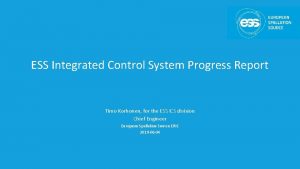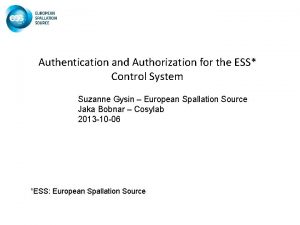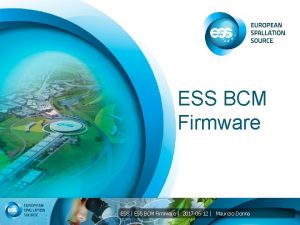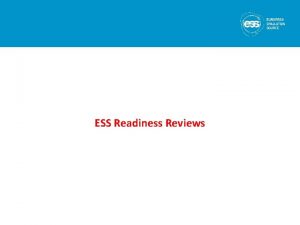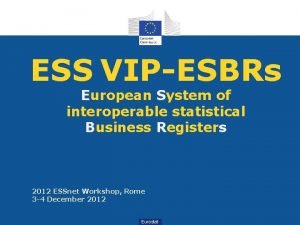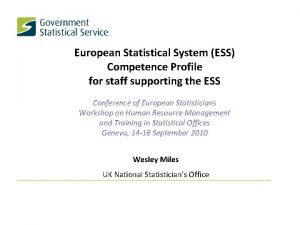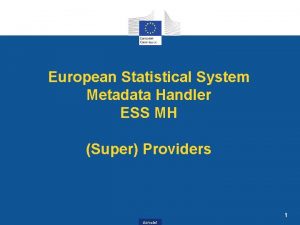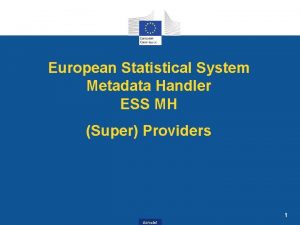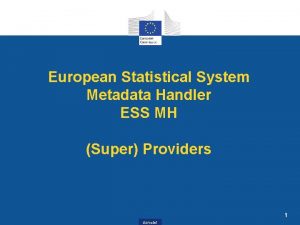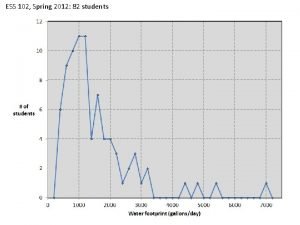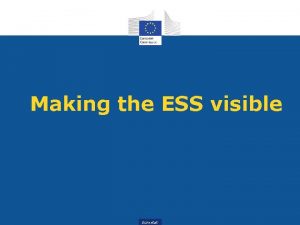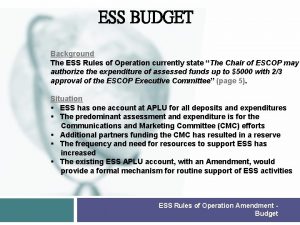The European Statistical System European Statistical System ESS

























- Slides: 25

The European Statistical System

European Statistical System (ESS) • ESS functions as a network. • It is based on cooperation and coordination between Eurostat and the EU Member States + EFTA + CH. ESS members collect and process the national data Eurostat processes data received and disseminates official European statistics 2

Regulation 223/09 on European statistics • ESS is legally recognised and defined for the first time • Development, production and development of European statististics • Introduces statistical principles: professional independence, impartiality, objectivity, reliability, statistical confidentiality, cost effectiveness (Art 2) • Establishes the ESS Committee (Art 7) • Introduces concept of collaborative networks (Art 15) • Introduces European approach to statistics (Art 16) • Specifies that Eurostat is responsible for coordination the statistical activities of the EU institutions 3

Eurostat‘s role within the ESS § Eurostat mission: to be the leading provider of high quality statistics on Europe. § Lead the way for harmonised and comparable European statistics in compliance with the European Statistics Code of Practice. § Initiate work programmes § Disseminate European statistics. § Facilitate functioning of the ESS, provide training, staff exchange. § Encourage cooperation, speak on behalf of the ESS: NSIs, candidate countries, European Central Bank, international organisations (UN, OECD, IMF, World Bank) 4

Eurostat‘s role within the European Commission Defined by Eurostat decision 2012/504/EU of 17 September 2012 • • Professional independence Chief Statistician Co-ordination of European and other statistics Definition of European statistics Initiate and implement EU legislation – Guardian of the treaties 5

The European Statistical System governance bodies 6

ESS committees and bodies 7

European Statistical System Committee (ESSC) • At the heart of the ESS • Established by Regulation 223/2009 • Eurostat and representatives of Member States = National Statistical Institutes (NSI) • Observers: EFTA, ECB, OECD etc. • Chaired by Director General of Eurostat • Meets 4 times a year

ESSC tasks • Art. 7 of 223/2009: "… professional guidance for developing, producing and disseminating European statistics" • The measures and actions that the Commission intends to take in the field of statistics • Planning - Annual Work Programme (AWP) • Response burden / reprioritisation • Statistical confidentiality methodology • Code of Practice (Co. P) • ESSC to be the only committee taking decisions on comitology issues for the ESS 9

ESSC agenda 1. Comitology items 2. Items for opinion 3. Items for discussion 4. Reports to the Committee ESSC consultations under comitology • Binding legal acts • Not: agreements, guidelines etc. • Qualified majority: at least 15 delegations, 62% of population 10

The Partnership Group § Main tasks: § Facilitate the work of the ESSC, prepare agenda and discussions at strategic level § Foster cooperation between NSIs § Strengthen the strategic capacities of the ESS through internal discussions, stakeholder dialogues, etc. 11

The Partnership Group § Members (10 + 2 secretariat): § elected Chair from a Member State (currently Sweden), § Eurostat’s Director General (Vice-chair) and Deputy DG, § the Heads of NSIs of the previous, current and next Council Presidencies, § four elected Heads of NSIs 12

The DGINS Conference Annual conference organised jointly by a hosting Member State and Eurostat: § discuss internal ESS organisational issues § thematic statistical topic of general interest § attended by Heads of NSIs, including Candidate and Western Balkan countries 2011: Germany: “Next generation of the Code of Practice” and “New conceptual design for household and social statistics” 2012: Czech Republic: “Green economy” and “Geospatial statistics” 2013: The Netherlands: "Big Data" 2014: Latvia: "Towards global business statistics" 13

Advisory bodies to the European Statistical System 14

European Statistics Code of Practice • Self-regulatory instrument adopted by the NSIs in 2005, revised in 2011 • Structured around 15 principles under 3 sections: • institutional environment • statistical processes • statistical output • Key indicators of good practice for each principle 15

European Statistical Governance Advisory Board (ESGAB) Members: • • 7 members for 3 -year-term, renewable once, non-remunerated Nominated by Parliament and the Council Eurostat represented as an observer ESGAB was created in 2008; team 2012 -2015 about to be renewed Annual report to EP and Council on compliance with the Code • In 2014 Report focus only on Eurostat peer review Opinions on: • Revision of the Code of Practice • Communication "Towards robust quality management" • ESA 2010 Letters to Member States on governance issues 16

European Statistical Advisory Committee (ESAC) Members: • 24 for 5 -year-term, renewable once, non-remunerated • Members a mix of users, respondents, producers and stakeholders: o 11 appointed by the Commission o Eurostat Director General ex-officio o 12 appointed by EU institutions and bodies, ESSC, number of associations operating at European level • ESAC was created in 2008; second terms started in 2013 Opinions and advice: • Work programmes • Own initiatives e. g. SIMSTAT, resources • Relevance of European statistics Seminars on selected topics: • Quality, Quality of Life, Conference on Eur Statistics Stakeholders 17

Cooperation between the European Statistical System (ESS) and the European System of Central Banks (ESCB) 18

European Statistical Forum (ESF) Created by the Mo. U between the members of the ESS and the members of the ESCB - April 2013 Members: • • 1 representative per Member State from the ESSC 1 representative per Member State from the STC (Statistics Committee) 1 representative from Eurostat + 1 from ECB Co-Chaired by Chair of ESSC + Chair of STC Tasks: • Cooperation between both systems • Exchange of information • Work programme and priorities for cooperation Meets once a year (met in Nov 2013 and Sept 2014) 19

Bureau of the European Statistical Forum Members: • • 2 Co-Chairs of the Forum (Chair of the ESSC + Chair of the STC) Chair and Vice-Chair of the CMFB 2 members representing National Statistical Institutes 2 membres representing National Central Banks Tasks: • Prepare the ESF meetings • Own initiatives e. g. SIMSTAT, resources • Relevance of European statistics Meets once a year, 3 months before the ESF (met in Sept 2013 and June 2014) 20

ESS Vision 2020: Future governance body 21

Vision Implementation Group (VIG) Purpose: to oversee the successful implementation of the ESS Vision 2020 Scope: current and future VIPs, ESSnets and other vision implementation initiatives Not responsible for: • Starting/stopping projects • Allocating funds to new or ongoing projects • Operational decisions within individual projects Members: • Around 10 MS (EFTA incl) on a rotational basis • Chair Eurostat + Deputy Chair • Deputy DG level

Concrete achievements for the ESS § New legal framework setting up the system, composed of partners at a national and European level. § European Statistics Code of Practice and progress towards robust quality management – new round of peer reviews § Streamlined governance structure encompassing the inputs from all levels – DGs, Director Groups, TFs § New ESS Vision 2020, endorsed in May 2014 23

Challenges § Increasing statistical demands and development of new statistics in times of resource constraints. Relevance, timeliness § Role of statistics in decision-making puts more pressure on the statistical community. § Need to decrease burden on respondents. § Increased competition from other information providers. § New techniques, globalisation, new communication and learning habits. § . 24

Further information • ESS: http: //epp. eurostat. ec. europa. eu/portal/page/portal/ess_eurostat/introduction • ESGAB. http: //ec. europa. eu/esgab • ESAC: http: //epp. eurostat. ec. europa. eu/portal/page/portal/esac/introduction
 European statistical system committee
European statistical system committee Ess control system
Ess control system Ess cooling
Ess cooling Ess cooling
Ess cooling Ess control system
Ess control system Ics integrated control systems
Ics integrated control systems Ess control system
Ess control system Ess control system
Ess control system Hát kết hợp bộ gõ cơ thể
Hát kết hợp bộ gõ cơ thể Slidetodoc
Slidetodoc Bổ thể
Bổ thể Tỉ lệ cơ thể trẻ em
Tỉ lệ cơ thể trẻ em Chó sói
Chó sói Chụp tư thế worms-breton
Chụp tư thế worms-breton Chúa yêu trần thế alleluia
Chúa yêu trần thế alleluia Các môn thể thao bắt đầu bằng từ đua
Các môn thể thao bắt đầu bằng từ đua Thế nào là hệ số cao nhất
Thế nào là hệ số cao nhất Các châu lục và đại dương trên thế giới
Các châu lục và đại dương trên thế giới Cong thức tính động năng
Cong thức tính động năng Trời xanh đây là của chúng ta thể thơ
Trời xanh đây là của chúng ta thể thơ Cách giải mật thư tọa độ
Cách giải mật thư tọa độ 101012 bằng
101012 bằng Phản ứng thế ankan
Phản ứng thế ankan Các châu lục và đại dương trên thế giới
Các châu lục và đại dương trên thế giới Thể thơ truyền thống
Thể thơ truyền thống Quá trình desamine hóa có thể tạo ra
Quá trình desamine hóa có thể tạo ra






